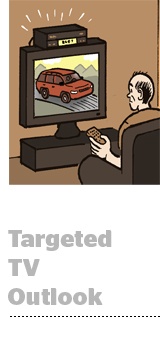 Addressable TV significantly expanded in 2016, both in terms of ad spend and the size of the total addressable market.
Addressable TV significantly expanded in 2016, both in terms of ad spend and the size of the total addressable market.
In 2015, addressable TV ad spend reached $400 million in the US and grew to $890 million in 2016, according to eMarketer. That’s quadruple the spend flowing into the marketplace in 2014.
Last year, more households became addressable partly because of the all the content that coalesced across IP, over-the-top and on-demand platforms, said Stephanie Mitchko-Beale, CTO and COO of TV sales network Cadent.
“This has given advertisers and brand managers the ability use addressable platforms in a bigger way, as opposed to small, siloed platforms of the past,” she said.
Cable and satellite operators also improved their abilities to deliver addressable ads, with close to 50 million set-top boxes now enabled for addressable campaigns. Time Warner Cable, for instance, rolled out addressable targeting in 11 million households.
AT&T grew to 14 million addressable households when it merged with DirecTV and made an investment in addressable TV ad platform Invidi.
And Twenty-First Century Fox just revealed plans to acquire British broadcaster Sky for $14 billion, which reaches 98 million households in five European countries.
The ability to offer addressable audiences is increasingly important because Google and Facebook are trying to take TV ad budgets, while Netflix, Hulu and Amazon are poised to take more share of wallet in paid television.
“The only way to extend their businesses through the open, neutral Internet is by owning the consumer experience end to end and being able to sell advertising on a performance basis, with attribution built into the sale,” said Ashwin Navin, CEO of Samba TV.
The media companies with large addressable footprints can provide their advertisers with more value via better planning/audience discovery, TV execution and measurement.
These benefits are especially important as advertisers demand apples-to-apples comparisons for addressable TV and digital audience segments.
And data companies are also gearing up for an addressable world, creating offerings that can unite different data sets and apply them to TV audience buying.
“We see a steady stream of new data sources, from first-party CRM data to syndicated location-based measurement sources,” said Eric Schmitt, VP of advanced advertising for Acxiom’s addressable TV business.
Digital data management platform Lotame teamed up with local broadcast group Pearl TV for audience matching, Acxiom accelerated its addressable TV platform, DISH opened up its supply to more than 150 demand partners via BidSwitch and Cadent launched a TV targeting tool that tapped into TiVo’s data set.
Addressable TV In 2017
But 2017 will still bring fresh challenges for the addressable TV industry.
“Addressable TV will grow, but it faces the same headwinds that face [linear] television: both in terms of declining television subscribers and spotty inventory avails that limit reach,” said Samba TV’s Navin.
Additionally, buyers and sellers will need a data reality check.
Though the total availability of TV viewership data from cable distributors and other suppliers is increasing, so are the discrepancies.
A growing number of agencies and brands are supplementing data supplied by TV networks with their own first- and third-party data to prove out incrementality around their big-ticket linear buys.
Although useful in demonstrating ad effectiveness for a target audience, “the lack of audience data interoperability across sellers and buyers will constrain innovation,” which makes it harder to pull off true apples-to-apples comparisons across networks or platforms, predicts Acxiom’s Schmitt.
Despite these challenges, 2017 could bring more addressable – or, what some might call programmatic TV – network inventory, historically limited to two minutes per hour of spot cable and satellite inventory.
“Early examples of household addressable TV campaigns in programmer video-on-demand (VOD) inventory are now underway,” Schmitt said. “In 2017, we’re likely to see those tests expanded to include linear avails, as distributors begin to enable the 14 to 16 minutes per hour of spots on national cable and broadcast network inventory. Frequency capping is likely the killer app.”
This post was syndicated from Ad Exchanger.

More Stories
Around the World: Elon Musk’s brand freefallin’ and celebrity splits shine in marketing
Daily Wire Welcomes Perplexity to Advertise on The Ben Shapiro Show
Here’s the Roundup for the Week Ending March 7